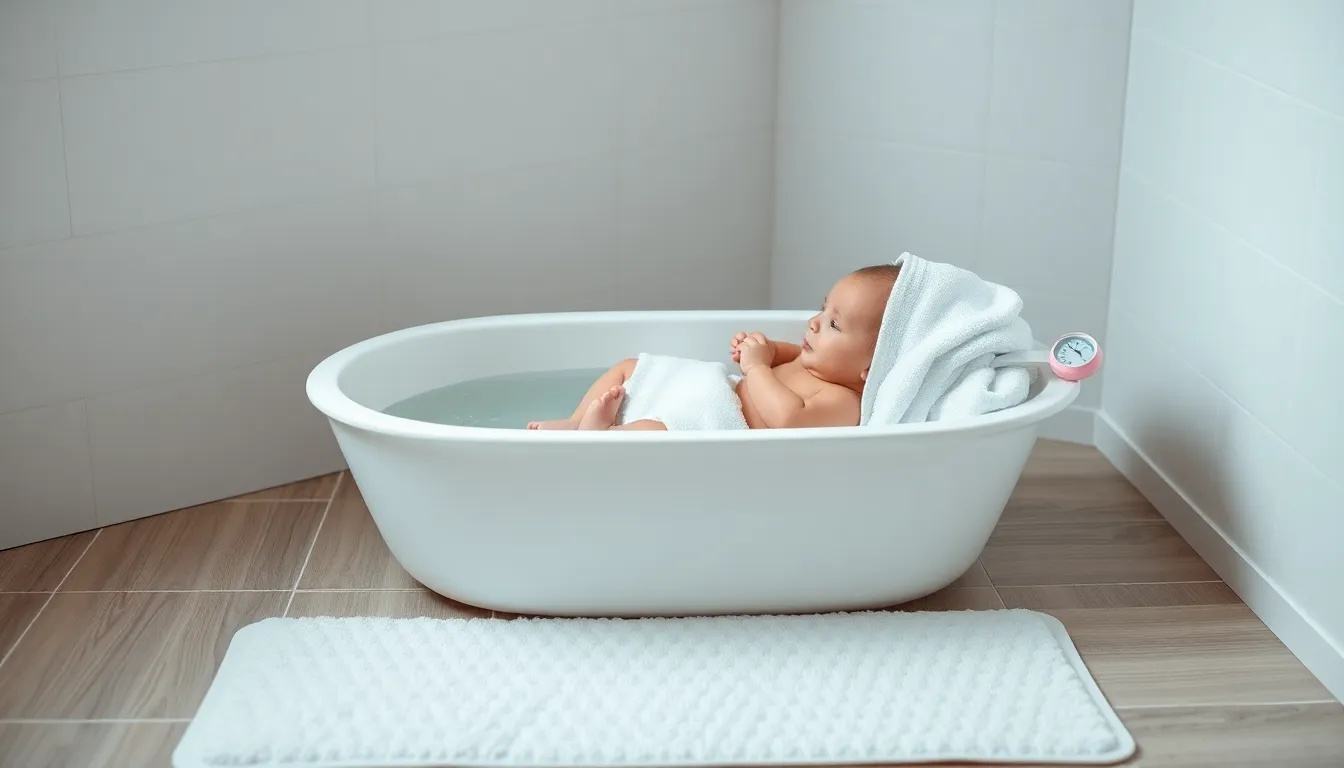Table of Contents
ToggleBath time for a newborn might sound like a scene from a comedy show, but it’s a crucial bonding experience for parents and their little ones. Picture this: a tiny human, all wrinkly and wobbly, splashing around like they just won the lottery. It’s not just about getting clean; it’s about creating memories that’ll make you chuckle for years to come.
Understanding Newborn Bath Time
Bath time for newborns serves as a significant bonding experience for parents and infants. This routine fosters connection, promotes hygiene, and creates joyful memories.
The Importance of Bathing a Newborn
Bathing a newborn offers multiple benefits beyond cleanliness. This practice encourages skin health by removing cradle cap and formula residues. It also enhances relaxation, making babies feel calm and secure. Many parents find that bath time can soothe fussy infants while forming a nurturing ritual. Establishing this routine helps infants adapt to their new environment, enhancing their overall comfort and well-being.
When to Start Bathing Your Newborn
Timing plays a crucial role in initiating bath time for a newborn. Many experts recommend starting sponge baths within the first few weeks after birth. Parents can introduce a full bath once the umbilical cord stump falls off, usually around two weeks. Observing the baby’s skin is vital; dry or irritated areas may require gentle cleansing alternatives. It’s important to provide a safe and warm environment to ensure the comfort and safety of the baby during bath time.
Preparing for Bath Time

Preparing for bath time involves gathering necessary supplies and ensuring safety measures are in place. A calm environment promotes a positive experience for both babies and parents.
Necessary Supplies and Equipment
Gather essential items before bathtime. A shallow tub or basin works well for newborns. Use a soft washcloth and gentle baby soap designed for sensitive skin. Choose warm, soft towels to wrap the baby afterward. Keep an infant bathing chair or sponge nearby for added support. Include a baby thermometer to check water temperature, ensuring it stays between 98°F and 100°F. Additionally, have a clean diaper and fresh clothes ready for after bath time, making transitions smoother.
Safety Precautions
Ensuring safety during bath time is crucial. First, never leave a baby unattended in the water, even for a moment. Use a non-slip mat to prevent slipping and sliding during the bath. Always check the water temperature before placing the baby in the tub. Ideally, it should feel warm, not hot. Keep the bathing area free of clutter to avoid accidents. Support the baby’s head and neck throughout the bathing process, maintaining a secure grip. Using these safety precautions enhances the bathing experience while minimizing risks.
Bathing Techniques
Bathing newborns requires specific techniques to ensure safety and comfort. Understanding the difference between sponge baths and tub baths aids in selecting the best method for infants.
Sponge Baths vs. Tub Baths
Sponge baths occur during the first few weeks. Parents use a damp washcloth to clean the baby’s body, avoiding the umbilical cord stump. This method minimizes the risk of infection. Tub baths become suitable once the cord stump falls off, usually around two weeks after birth. Full immersion bathing promotes a relaxing environment, enhancing the baby’s enjoyment. Each method serves its purpose, with sponge baths focused on cleanliness and tub baths providing an opportunity for bonding.
Step-by-Step Bathing Process
Following a structured bathing process ensures both safety and enjoyment. First, gather all supplies within arm’s reach. Second, fill the tub or basin with just a few inches of warm water, ideally around 100°F (37.8°C). Third, gently undress the baby, maintaining warmth with towels. Fourth, support the baby’s head and neck while using a soft washcloth to clean their body. Fifth, rinse off soap thoroughly to avoid skin irritation. Lastly, wrap the baby snugly in a warm towel, keeping them comfortable and cozy. Following these steps makes bath time efficient and pleasant for everyone involved.
Post-Bath Care
Post-bath care for newborns focuses on ensuring comfort and skin health. After the bath, proper drying and dressing are crucial steps.
Drying and Dressing Your Newborn
First, use a soft towel to gently pat the baby dry. Start with the head and move down to the toes, paying special attention to areas such as the folds of the skin where moisture can linger. Keep the baby wrapped in a towel to maintain warmth. Next, select a comfortable outfit that fits properly, avoiding constrictive clothing. Ensure the clothing is made of breathable fabric to prevent irritation. Finally, choose a suitable space to dress the baby, ensuring it is warm and free from drafts for the baby’s comfort.
Moisturizing and Skin Care Tips
Moisturizing immediately after drying enhances skin hydration. Use a gentle baby lotion or oil, rubbing it in gently to cover all skin, especially in dry areas like elbows and knees. Pay attention to the scalp, as mild cradle cap can occur. Regular moisturizing helps keep the skin supple and healthy. Check for any signs of irritation or rash during this process. If any redness or discomfort appears, consult a pediatrician for further guidance. Establishing a routine enhances skin health and provides bonding time with the baby.
Common Challenges and Solutions
Bath time can present challenges for new parents. Addressing these hurdles effectively leads to a more enjoyable experience for both the baby and parents.
Dealing with Crying and Discomfort
Crying during bath time is common. Babies may feel vulnerable or cold, causing distress. Preparing a warm, soothing environment can alleviate discomfort. Keeping the room warm prevents chills, while using warm water helps the baby relax. Supporting the baby’s head and neck during the bath enhances their sense of security. Engaging in gentle talk or singing throughout the experience can further soothe the infant. Parents might also benefit from selecting a time when the baby is alert and calm, improving the likelihood of a peaceful bath.
Addressing Skin Issues
Skin issues can arise during the early months, such as dryness or irritation. Regularly moisturizing right after bath time helps maintain hydration. Parents should choose gentle, fragrance-free lotions specifically designed for babies. It’s essential to check for signs of irritation or rashes during bath time, as early detection can prevent worsening conditions. Avoiding soaps with harsh chemicals can also minimize the risk of skin issues. Consulting a pediatrician for persistent skin problems ensures proper care is provided, fostering skin health for the newborn.
Newborn bath time is more than just a hygiene routine; it’s a cherished opportunity for bonding and creating joyful memories. By establishing a consistent bathing routine and following safety precautions parents can ensure a positive experience for their little ones. Emphasizing gentle techniques and post-bath care not only promotes skin health but also fosters a sense of security for the baby.
Navigating challenges during bath time becomes easier with the right preparation and a soothing environment. As parents embrace this delightful ritual they’ll find themselves not just cleaning their newborn but also nurturing a deeper connection that lasts a lifetime.







